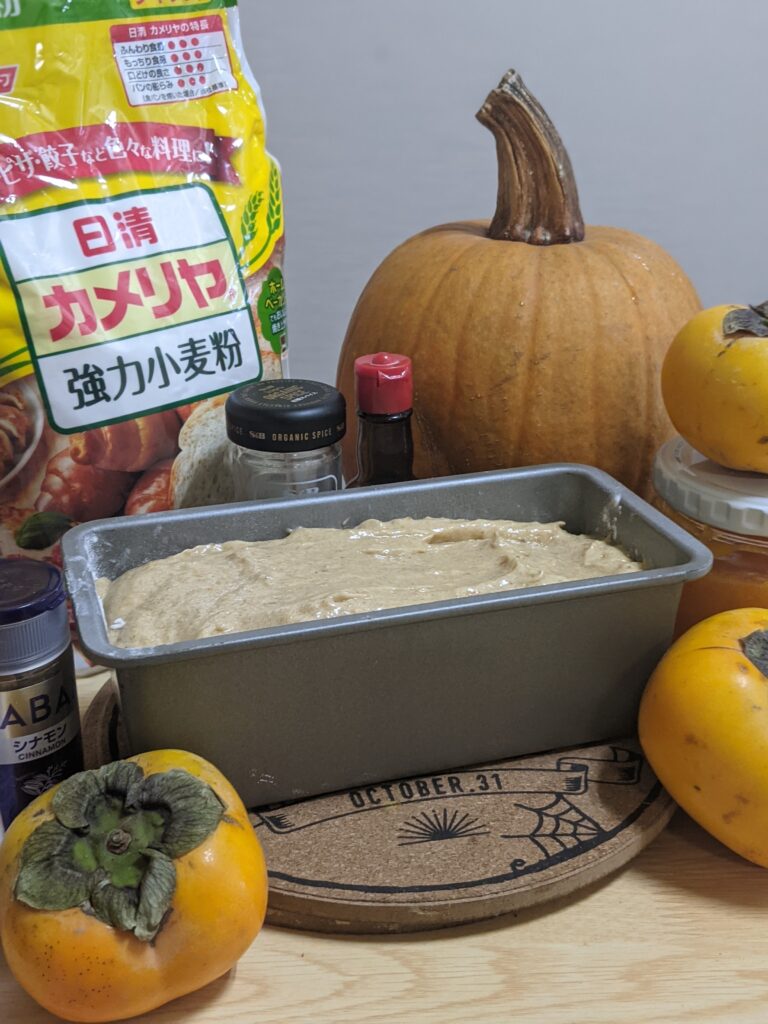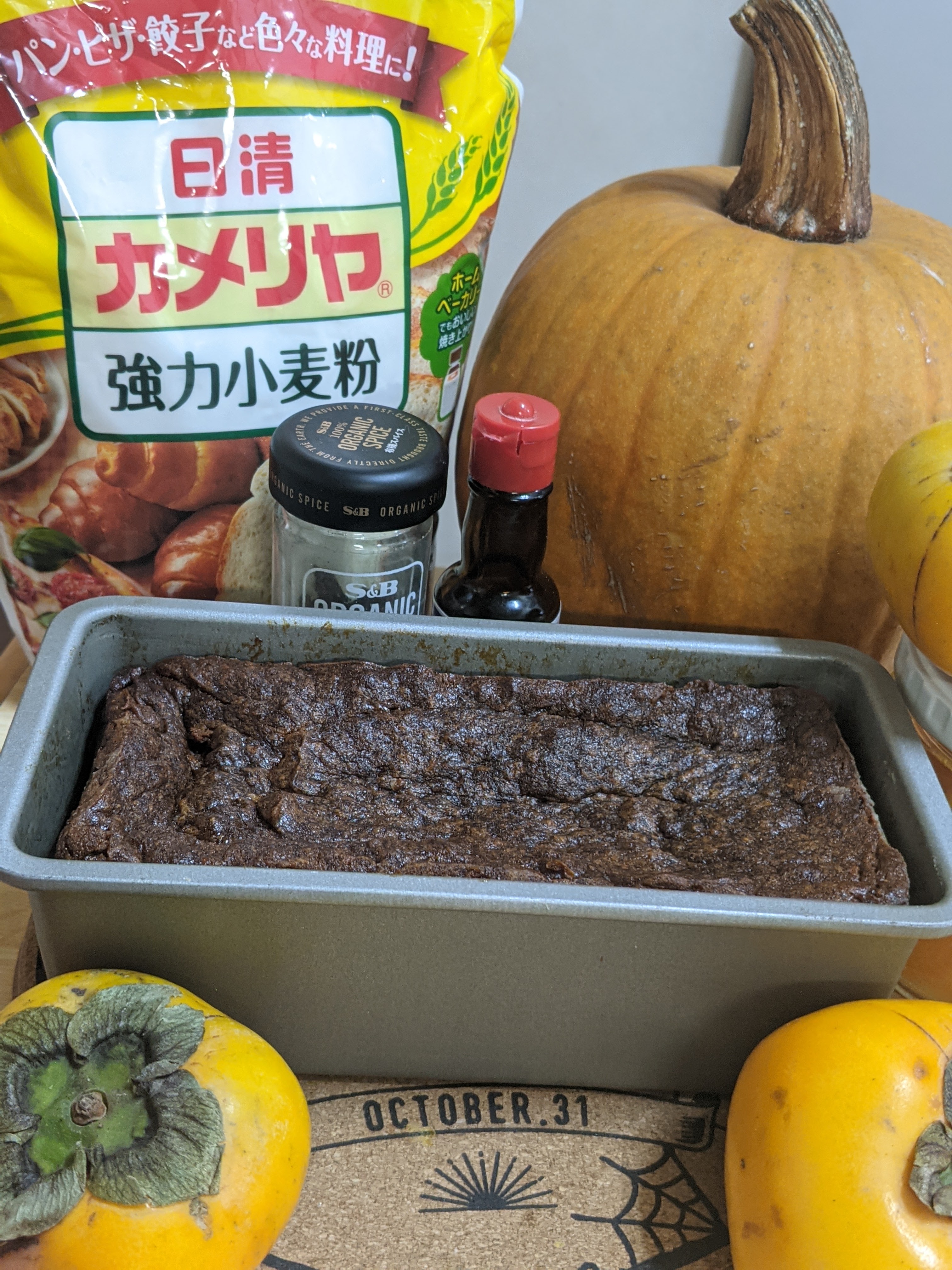This article originally featured in the November 2021 issue of Connect.
Kimberly Fitzgerald (Wellness Editor)
The first time I saw a persimmon, I thought I was looking at some strange, orange variety of tomato. So, when the shop clerk showed me that she peeled them and hung them on a string to make “Japanese sweets,” I was confused to say the least. However, I soon discovered the sweet decadence of “hoshigaki” (dried persimmons) and the silky, honey-like flavor of a ripe persimmon. Ever since that day, I’ve set off on a mission to try to incorporate this seasonal delicacy into as many dishes as I can.
 The fruits are in season from October to December, and when fully ripe, persimmons are incredibly soft and almost jelly-like on the inside. They are so soft that it is difficult for farmers to transport ripe persimmons. Because of this, persimmons are often harvested before they are ripe. This is not a problem for non-astringent persimmons, like Fuyu, which are sweet all the time. But the varieties with high levels of soluble tannins, like Hachiya, are inedible due to their astringency if not fully ripe. However, by exposing an astringent persimmon to CO2, the soluble tannin level is reduced and the sweet, honey-like flavor of the persimmon is brought out. While most persimmons sold in stores are either of the non-astringent variety or have already been “treated” to remove the astringency, it is always recommended to ask if a persimmon is astringent or not if receiving it as a gift.
The fruits are in season from October to December, and when fully ripe, persimmons are incredibly soft and almost jelly-like on the inside. They are so soft that it is difficult for farmers to transport ripe persimmons. Because of this, persimmons are often harvested before they are ripe. This is not a problem for non-astringent persimmons, like Fuyu, which are sweet all the time. But the varieties with high levels of soluble tannins, like Hachiya, are inedible due to their astringency if not fully ripe. However, by exposing an astringent persimmon to CO2, the soluble tannin level is reduced and the sweet, honey-like flavor of the persimmon is brought out. While most persimmons sold in stores are either of the non-astringent variety or have already been “treated” to remove the astringency, it is always recommended to ask if a persimmon is astringent or not if receiving it as a gift.
The scientific name for persimmons, Diospyros kaki, means “food of the gods” (from Greek; “dios” meaning god and “spyros” meaning food). (1) It’s fitting, as these sweet little orange fruits pack as much good-for-you power as a Greek god. Persimmons are enriched with many bioactive compounds, including antioxidants, flavonoids, carotenoids, minerals, and dietary fiber. (2)
The fruit of a persimmon is also rich in vitamin A, with some varieties reaching up to 70 mg per 100 g. (2) Vitamin A is critical for your vision as it assists the retinal receptors in absorbing light. (3) In addition to vitamin A, persimmons also contain lutein, zeaxanthin, and other carotenoids which are important for eye health. (4)
Though many Japanese people consider the peel of a persimmon to be a waste, nutritionists actually recommend eating the peel as it has carotenoids and antioxidants, including vitamin C, in even higher concentrations than in the fruit itself. (2)
Even the leaves of persimmons are good for you! When brewed into tea, persimmon leaves release compounds that help reduce blood pressure. And because the leaves have an antimicrobial and anti-wrinkle effect, they have been incorporated into face creams, detergents, and even socks! (2)
But perhaps the most surprising fact is that dried persimmon snacks, like the hoshigaki that baffled me during my first few months in Japan, have been found to be effective in reducing the concentration of alcohol in the blood. (2)
So, whether you are looking for something to keep your eyes healthy, help you recover from your night out, or are just looking for a sweet treat, we recommend a true seasonal fruit, the persimmon. And for those already in love with persimmons and looking to incorporate it into other dishes, please check out the two wonderful recipes that will surely make you fall in love with the flavors of fall.
References
(1) Persimmon Production and Market
(2) Chemistry and Functionality of Bioactive Compounds Present in Persimmon
(3) Vitamin A – Health Professional Fact Sheet (nih.gov)
(4) Health and Nutrition Benefits of Persimmon
Fried Pork and Persimmon
Original recipe by Kazuyo Nakajima translated and adjusted by Sarah Underwood (Tokyo)
This recipe is great for an evening when you want a quick and easy meal. Persimmons add sweetness to the dish and compliment the savoriness of the pork. This dish is a great way to try cooked persimmons, especially if you’ve only had them raw! The recipe makes about two servings.
Ingredients:
- 150 gram pork cutlet
- Salt and pepper (to taste)
- 1 persimmon
- ½ bundle of Japanese mustard spinach (komatsuna)
- 4 cm lotus root (]renkon)
- 1 teaspoon sake
- 2 teaspoons soy sauce
- A pinch of chopped red pepper (togarashi)
- 1 tablespoon sesame oil
Instructions:
- Cut the pork cutlet into small pieces and season with salt and pepper.
- Remove the stem of the persimmon, peel, and cut into sticks roughly the same size of the pork cutlet.
- Cut the roots of the komatsuna, then rinse. While still semi-wet, wrap the komatsuna in plastic wrap and microwave for one to two minutes. Once soft, squeeze out water and cut into three centimeter strips.
- Rinse the lotus root skin with water and cut into long, thin strips.
- Heat the sesame oil in a frying pan with medium-high heat and stir-fry the pork and lotus root, followed by persimmon and komatsuna. Saute until the pork and lotus root are cooked thoroughly, approximately three to five minutes.
- Once everything has been cooked and is well coated in sesame oil, add the seasonings.
- Finish stir-frying and serve in a bowl. Additionally, you can top it off with crushed white sesame seeds to enhance the flavor!
Sarah came back to Tokyo, Japan via JET in 2019. She loves playing piano, board games, and visiting art exhibits. She also loves trying to befriend every cat she comes across.
Spiced Persimmon Bread
Emily Herrington (Yamanashi)
With autumn fully in the air, it’s time for hot drinks, spicy flavors, and warm food to help us enjoy the kouyou season. This recipe uses Japan’s favorite fall-colored produce, which can often be spotted along country roadsides. No, it’s not pumpkins—but persimmons! This spiced persimmon bread recipe uses persimmons and is a great Japanese twist on a classic North American pumpkin bread.

Notes: For this recipe, fully-ripe Fuyu persimmons are best, but Hachiya also work. The riper the fruit, the more flavor will come through. If you happen to have both on hand, dried/sugared hachiya slices are a great way to decorate the tops of your loaves! It’s also great with American-style cream cheese frosting.
Please note that you will need an oven or a toaster oven with a convection setting on it to make this bread.
Ingredients:
- About 4 medium or 7 small permissions
- 500 ml (2 cups) all-purpose flour
- 2.5 ml (1/2 teaspoon) salt
- 5 ml (1 teaspoon) ground cinnamon
- 2.5 ml (1/2 teaspoon) ground nutmeg
- 2.5 ml (1/2 teaspoon) ground cloves
- 5 ml (1 teaspoon) baking soda
- 2.5 ml (1/2 teaspoon) baking powder
- 180 ml (3/4 cup) unsalted butter, room temperature (plus extra for pan-prep)
- 500 ml (2 cups) white sugar
- 2 large eggs, room temperature
Directions:
- First, you’ll need to make the persimmons into persimmon purée. Wash the persimmons under cold water. After drying them off, use a paring knife to carefully cut off the stem, skin, and any overly brown or bruised spots. It’s okay if some skin is left, but getting most of it off is essential to a smooth purée.
- Quarter each persimmon and put the slices into a blender. Blend until smooth. Set aside.
- In a large bowl, combine the flour, salt, cinnamon, nutmeg, ground cloves, baking soda, and baking powder. Whisk until well combined. Set aside.
- Preheat the oven/toaster oven to 160°C in convection mode. Generously coat the bottom and sides of the loaf pans with butter and lightly dust with flour (don’t miss the sides!).
- In another large bowl, add the butter and sugar. Whisk roughly for about one minute, until just blended. Slowly beat in each egg one at a time, whisking briskly. Once the wet batter seems light and whipped, it’s ready for the purée!
- Whisk the persimmon purée into the wet batter bowl for about one minute. Next, add the dry batter a third at a time, whisking until well-blended.
- Pour the batter into the pan(s), leaving two to three centimeters at the top for the bread to rise.
- For a 21x11x6 centimeter loaf pan, bake for 40-65 minutes, or until a toothpick inserted into the center comes out clean. You may need to adjust baking times depending on the size of your pans. Note: While the top will brown nicely and look done because it’s a moist dessert loaf, it may still need more time. So, be sure to use a toothpick to check that the loaf is fully cooked. Let cool for about 10-15 minutes before slicing.
Emily Herrington is a third-year JET who lives in Yamanashi prefecture. Emily has written about food, especially in educational spaces, and is interested in how our ideas about food are shaped by culture. When she’s not cooking at home or hiking one of Yamanashi’s “100 famous mountains” on the weekend, she is traveling to find a new craft brewery, tour a local sake distillery, or enjoy Japan’s farm-to-table dining. Check her quasi-food/quasi-adventure Instagram at @emily_eats_food.




